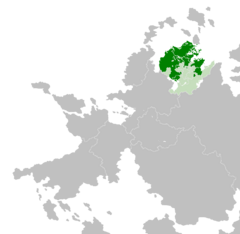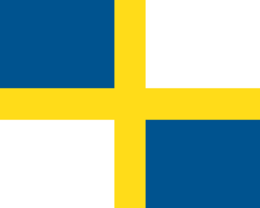Elbgau Confederation
This article is incomplete because it is pending further input from participants, or it is a work-in-progress by one author. Please comment on this article's talk page to share your input, comments and questions. Note: To contribute to this article, you may need to seek help from the author(s) of this page. |
Elbgau Confederation Elbgaubund (Hesurian) | |
|---|---|
| 1757–1793 | |
 The Elbgau Confederation upon its establishment in 1757: member states in green, remaining Mascyllary states in light green | |
| Capital | Langquaid (1757–85) Augusthal (1785–1793) |
| Common languages | Hesurian · Cuthish · Waldish · Temarian · Valimian · Cuthish · Falian |
| Religion | Semitarism |
| Government | Federal association of Mascyllary sovereign states |
| President of the Präsidialmacht | |
• 1757–1761 | Wilhelm IV |
• 1761–1784 | Albrecht II |
• 1784–1793 | Lukas I |
| Legislature | Federal Senate (Bundessenat) |
| Historical era | 1757–1793 |
| 20 December 1757 | |
• Constitution adopted | 8 January 1758 |
| 1 July 1769 | |
• Langquaid Imperial Diet | 16 September 1773 |
| 1774–1777 | |
| 1789–1793 | |
• Treaty of Langquaid | 18 May 1793 |
| Population | |
• 1760 | 7,830,150 |
| Currency | Mascyllary Unionsthaler (1757–1770) Mascyllary Reichsmark (1770–1793) |
| Today part of | |
The Elbgau Confederation (Hesurian: Elbgaubund), also referred to as the Elbgau Confederacy or North Mascyllary Confederation (Hesurian: Nordmaskillischer Bund) was a Mascyllary federal association of initially 12 sovereign states from its establishment by the Congress of Rehnern on 20 December 1757 until its dissolution by the Treaty of Langquaid on 18 May 1793. Although in essence a confederacy of states of equal stance, it was militarly, politically and economically dominated by the Kingdom of Aldia, the confederation's largest and most powerful member state. Following its creation, the confederation became a vehicle for states, most notably Aldia itself, to bring about the Mascyllary unification ultimately reached with the outcome of the War of the Five Kings and the dissolution of the confederation in light of its succeeding Mascyllary Kingdom, again under Aldian supervision and control, as a unified nation-state. While attempts had been made by Adwhin to establish a counterweight to the confederation with the remaining neutral Mascyllary states, efforts proved fruitless and led to a dramatic agrivation in tensions between Aldia and Adwhin which greatly upset the Mascyllary balance of power through three consecutive wars of unification fought between the Elbgau Confederacy and Adwhin in the 1740s, 1760s and 1770s.
The confederation remained largely ambiguous and inofficial when it was first founded, and only gained political traction when its federal constitution, the Langquaid Constitution (langquaider Reichsverfassung) was approved by its member states on 16 September 1773, as a reaction to rising nationalist, social democratic and liberal sentiments calling for a unified Mascyllary state with a democratic constitution having attempted to forcefully establish their vision in the Revolutions of 1769. Though the uprisings were suppressed by Aldia, Adwhin and other Mascyllary states, Aldian kings Wilhelm IV and Albrecht II recognized the opportunity for his country to claim the inherent right to unify Mascylla. Subsequently, the Elbgau Confederation became a pivotal and influential Mascyllary institution, and due to Aldia's significance in the confederation Wilhelm IV and his successors were awarded the position of head of state as President of the Bundespräsidium, de facto exercising full control over the confederation. Other institutions were results of demands made by the liberal elements of the unification movement: federal law could only be enabled by the approval of the Federal Senate (Bundesrat) composed of permanent envoys of the member states.
Today, most historians consider the Elbgau Confederation to be a mere puppet of Aldia, ineffective and indecisive in enforcing its own political opinions in favor of an Aldian vision of Mascyllary unification. However, it is seen as a major milestone of Mascyllary unification both politically, but also economically (via the North Mascyllary Customs Union (Nordmaskillischer Zollverein) in the 1760s) and to a broader extent, socially, embodying a symbol of unity among its member states.

